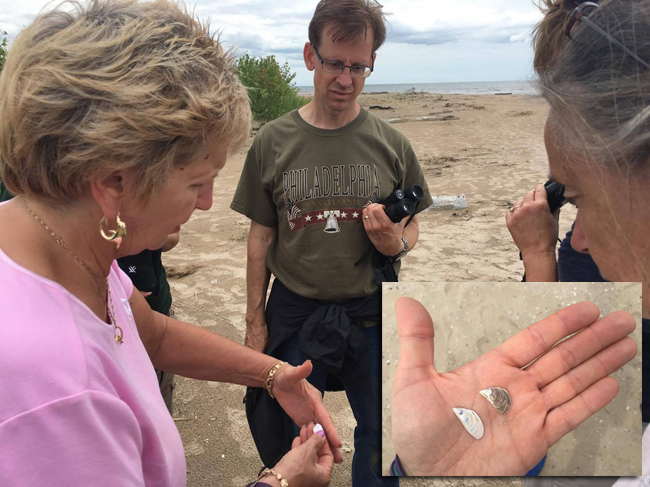
While filter-feeder activities of the exotic quagga and zebra mussel have helped to increase Lakes Ontario's water clarity, that in itself has introduced more concerns. For example, clearer water allows more light to penetrate, which in turn makes it more conducive for algae, like the pervasive Cladophora, to thrive, especially in warmer temperatures. Credit: Paul C. Focazio / NYSG
Contact:
Helen Domske, NYSG's Coastal Education Specialist, E: hmd4@cornell.edu
Brittney Rogers, NYSG's Extension Aide, P: 315-331-8415, E: Blr93@cornell.edu
Oswego, NY, July 27, 2017 - During a two day workshop along eastern Lake Ontario's shoreline, some 20 formal and informal educators learned more about the Great Lake ... from A (alewife) to Z (zooplankton).
"This was an opportunity for teachers in grades 4 through 10 to become better acquainted with the Lake's environmental issues," said NYSG's Coastal Education Specialist Helen Domske, who co-led the education excursion with NYSG Extension Aide Brittney Rogers. "If you want to get your students interested in this ecosystem there's no better way than to learn directly from the biologists and specialists who study the Lake."
While at the Rice Creek Field Station, the educators met with Eric Hellquist, a Associate Professor of Biological Sciences at SUNY Oswego. The focus of Hellquist's presentation was research addressing plastics in the marine environment. It's a topic that Domske addresses, too, via a fact sheet (pdf) and through a news archive.
"Unfortunately, there isn't an easy way to remove plastics from the Great Lakes once they are released into the water," said Domske. The only sure way to stop the threat, she added, is to prevent them from entering the ecosystem and consumers can help by selecting products that do not contain microplastics, minute plastic beads and fragments that are typically used as scrubbing agents or exfoliants in personal care products."
As seen in the photo series below, the teachers also visited the New York State Department of Environmental Consersation's (NYSDEC) Salmon River Fish Hatchery in Altmar, NY and explored the shoreline's sand dunes at Sandy Island Beach State Park.
For attending, the teachers obtained Center for Great Lakes Literacy-supported classroom activities to share with their students. Participants also received a $200 stipend with the opportunity to earn an additional $100 stipend during the 2017-2018 school year for conducting a Great Lakes stewardship project with their class.
The free workshop was provided through the New York Great Lakes Ecosystem Education Exchange (GLEEE) program, which provides hands-on, experiential learning opportunities focused on Great Lakes Literacy Principles and stewardship. More on this partnership between NYSG and NYSDEC at www.nyseagrant.org/educationexchange.
In Photos: Teachers Get Hands-On With Habitat Restoration, Fish Spawning, Marine Debris Education and More
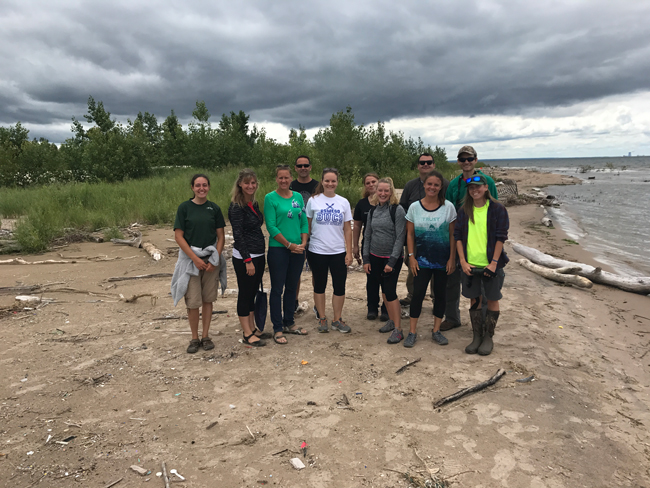
Using the “teach-the-teacher” workshop approach in which educators interact with scientists, NYSG coastal education programming prepares these and hundreds of others to better inform and engage thousands of students as the next generation of Great Lakes-literate citizens. Our program provides teachers with classroom-tested curriculum developed by Sea Grant, its federal parent agency the National Oceanic and Atmospheric Administration and other partners, encouraging infusion of Great Lakes information, from algal blooms to zooplankton, into classrooms. Credit: Brittney Rogers / NYSG
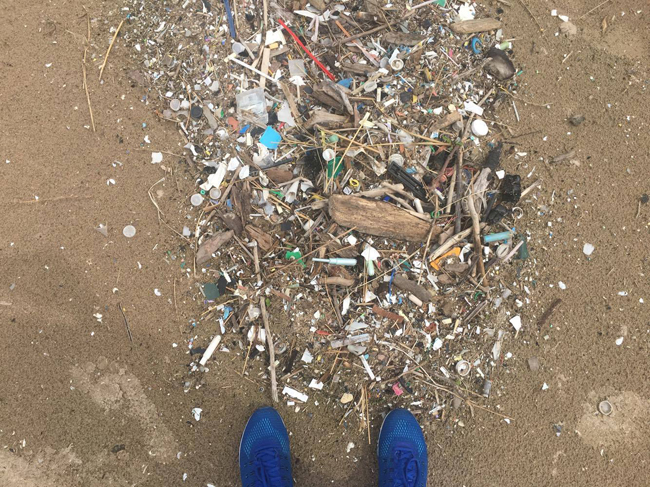
For years people have worried about the environmental impacts from plastics left behind in the oceans and Great Lakes. Pictures of birds tangled in six-pack rings or turtles choking on plastic bags have documented the danger of discarded plastics that linger in the environment. Recently, attention has turned to the Great Lakes and small plastic particles and microbeads that have been found there. Some plastic particles result from the breakdown of larger plastic items, but others are small plastic spheres known as microbeads. Credit: Paul C. Focazio / NYSG
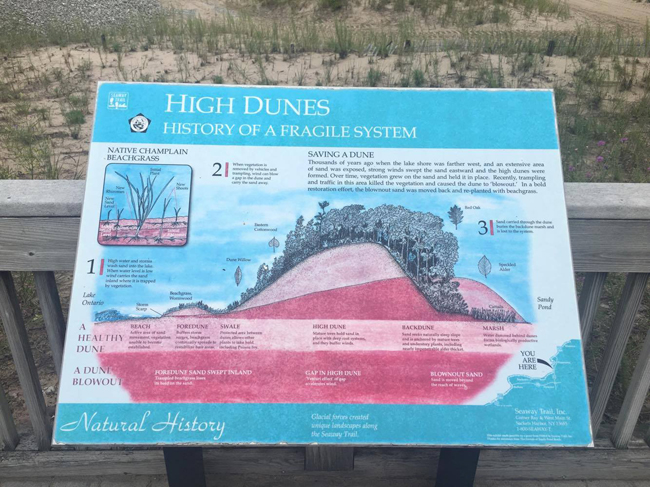
Sandy Island Beach is part of the Eastern Lake Ontario Dune and Wetlands Area, a 17 mile stretch - portions of which are seasonally accessible only by boat or kayak - that extends from the Town of Richland in Oswego County north along Lake Ontario to Jefferson County. The dunes were formed by wind and wave motion of a giant inland seas that preceded Lake Ontario. Credit: Paul C. Focazio / NYSG
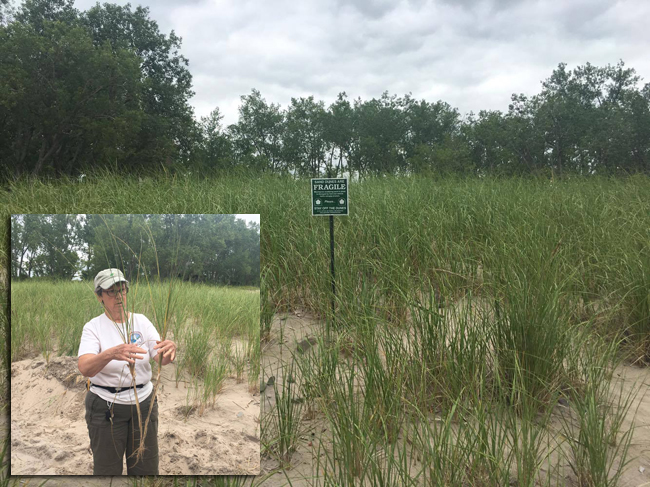
This stretch along the eastern Lake Ontario shoreline is the only significant freshwater dune site in the northeastern U.S. Along with the areas wetlands, woodlands, creeks and ponds, these sand dunes provide a unique habitat to several species of migratory birds and waterfowl, including sandpipers, plovers, killdeer, gulls and terns. Visitors may also glimpse fox, deer, beaver, snapping turtles and painted turtles moving among the wetland and shore areas. Credit: Paul C. Focazio / NYSG
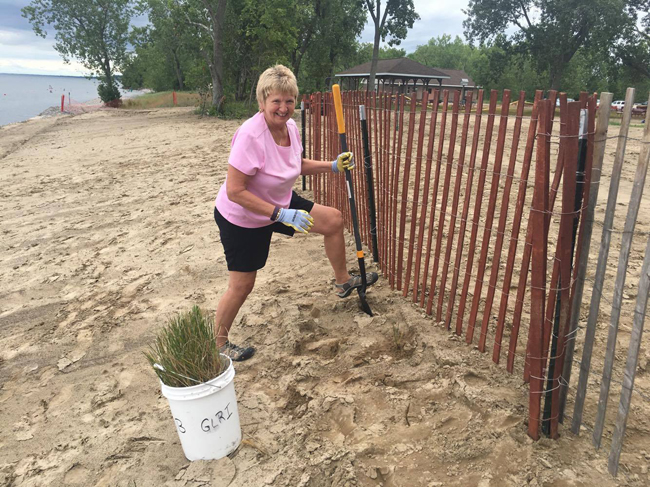
At least three rare or endangered plant species - the dune willow, dune grass and sand cherry - are native to the dunes, while the wetlands support over a dozen more rare plaints. Here, NYSG's Helen Dosmke and her workshop teachers helped plant native Champlain beachgrass along the lakeshore in hopes that it would help build up some protective dunes.
Credit: Paul C. Focazio / NYSG
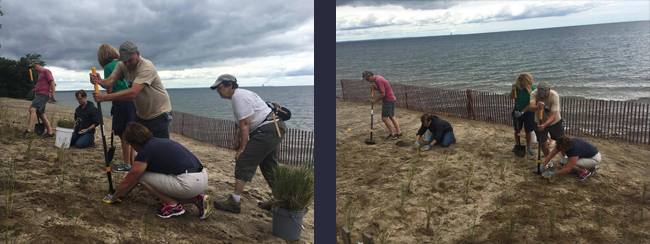
The educators plant dune-building grasses. Sand dunes act as a buffer or barrier, protecting the wetlands and other inland areas from the effects of high water, waves and currents as well as severe coastal storms. Credit: Paul C. Focazio / NYSG
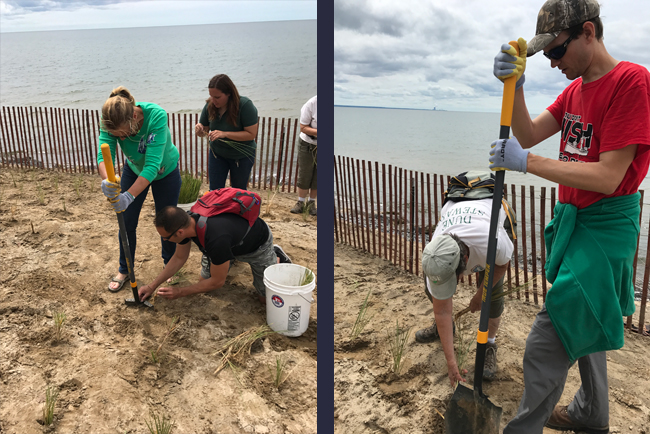
Without the dunes, coastal property along stretches of Lake Ontario shoreline like this one would be damaged by springtime floods, which were especially high this year. This could cause serious economic impacts for local inhabitants as well as damage to wetlands, the latter of which could lead to loss of habitat for wildlife and fewer recreational opportunities for local residents. Credit: Brittney Rogers / NYSG
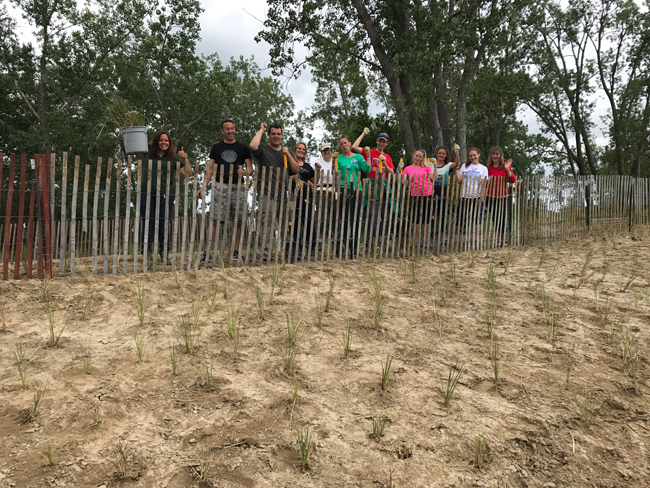
Two teams of educators helped plant many a row of beachgrass at Sandy Island Beach State Park.Credit: Paul C. Focazio / NYSG
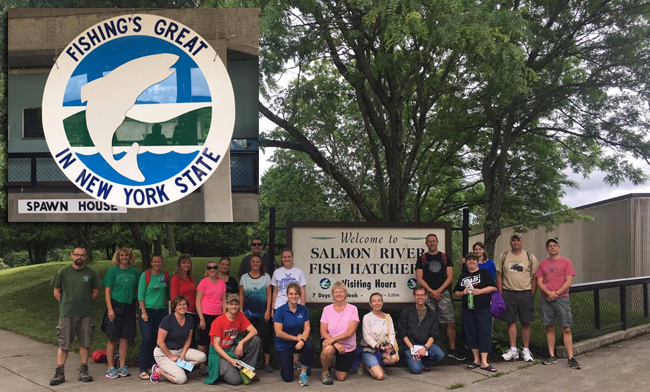
The operations of the Salmon River Fish Hatchery depend on the ability of salmon and trout to "imprint." Imprinting occurs when young fish ingrain into their memory the taste and smell of the water they are raised in. Fish raised here imprint just before swimming out of the smolt release pond to Beaver Dam Brook. From the brook they swim down the Salmon River to Lake Ontario. After two to five years, when it's time for them to spawn (reproduce), their imprinted sense of home leads them back to this hatchery. This happens in the fall for Chinook and coho salmon and in the spring for steelhead. Fish raised here for stocking in other streams and lakes are stocked before they imprint this hatchery's waters. Credit: Paul C. Focazio / NYSG
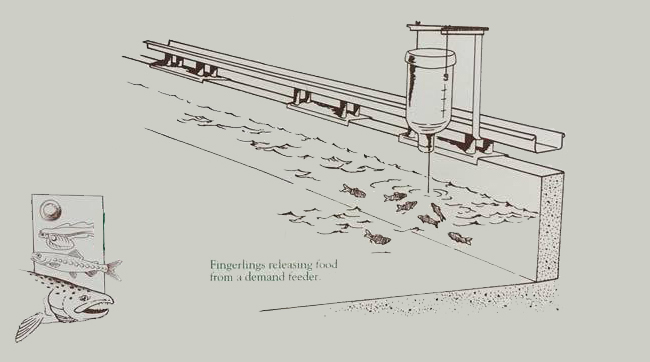
Fish are moved from the start tank room to a one of the hatchery's 24 outdoor rearing ponds when they are 2- to 3-inch-long fingerlings. They stay there for two months to a year, until they are 6 to 9 inches long and ready to be stocked in New York's Great Lakes and other waters throughout the state.
The signs on the front of the outdoor ponds tell which type of fish is living in each. The light brown containers above each pond are 'demand feeders.' By hitting the metal rod hanging from the funnel-shaped bottom of the feeders, the fingerlings release food into the water. The heavy nylon wires strung across the ponds prevent birds from catching and eating the fish.
Credit: Salmon River Fish Hatchery
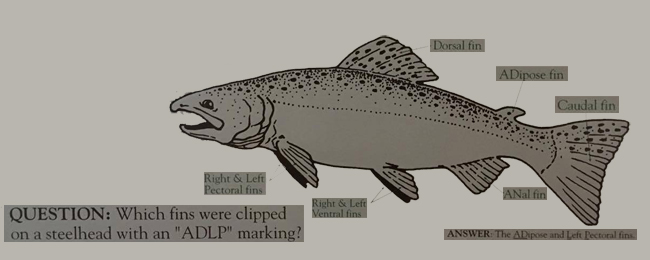
Another 10 ponds hold adult fish until, for example, they are ready to spawn. Each can hold up to 400 adults. The current fish inventory at the hatchery includes: brown trout (350,000 yearlings), rainbow trout / steelhead (850,000 yearlings), Chinook salmon (1.6 million fingerlings), and Coho salmon (250,000 yearlings). For more on these species, see "Salmon and Trout of Lake Ontario: A Visual Identification Guide" (pdf). Credit: Salmon River Fish Hatchery
More Info: New York Sea Grant
New York Sea Grant (NYSG), a cooperative program of Cornell University
and the State University of New York, is one of 33 university-based
programs under the National Sea Grant College Program (NSGCP) of the
National Oceanic and Atmospheric Administration (NOAA). The NSGCP
engages this network of the nation’s top universities in conducting
scientific research, education, training and extension projects designed
to foster science-based decisions about the use and conservation of our
aquatic resources. Through its statewide network of integrated
services, NYSG has been promoting coastal vitality, environmental
sustainability, and citizen awareness about the State’s marine and Great
Lakes resources since 1971.
New York Sea Grant maintains Great Lakes offices at SUNY Buffalo, the
Wayne County Cooperative Extension office in Newark and at SUNY Oswego.
In the State's marine waters, NYSG has offices at Stony Brook University
and Stony Brook Manhattan, in the Hudson Valley through Cooperative
Extension in Kingston and at Brooklyn College.
For updates on Sea Grant activities: www.nyseagrant.org has RSS, Facebook, Twitter, and YouTube links. NYSG produces a monthly e-newsletter, "NOAA Sea Grant's Social Media Review," via its blog, www.nyseagrant.org/blog. Our program also offers a free e-list sign up via www.nyseagrant.org/coastlines for its flagship publication, NY Coastlines/Currents, which is published 1-2 times a year.
More Info: New York State Department of Environmental Conservation
The New York State Department of Environmental Conservation (NYSDEC) was
created on July 1, 1970 to combine in a single agency, all-state
programs designed to protect and enhance the environment. The agency
consists of a Central Office in Albany, NY, and an office in each of its
nine regions that serve the communities within that region. The
department has 24 divisions and offices and a total of approximately
3,000 staffers working in the central and regional offices. Connect with
NYSDEC via www.dec.ny.gov, where you'll also find links to the organization's Facebook, Twitter and YouTube platforms.